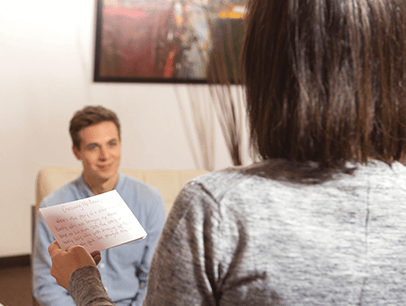
Just like you work out to make your muscles strong, you practice your speaking to become a stronger speaker. And if you want to be a strong public speaker, you need to warm up before you perform just like athletes and entertainers do.
Since 2011, I have been speaking professionally and coaching speakers. I developed a specific speaking warm-up routine after I blanked out during a District speech contest more than a decade ago. I’ve found that doing these simple exercises alleviates some of the most common physical and psychological issues that can cause confidence to dip right before speaking, specifically body tension and lack of belief in yourself and in your message.
Below is a five-minute warm up, and a 10-second confidence-boosting routine for right before you speak. I recommend performing most of the speaker warm-up exercises in a private space—the car, a hotel room, or a restroom—within half an hour of speaking. Some techniques, such as tactical breathing and visualization, can be done right before you take the stage. Download a one-page warm-up checklist here.
The 5-Minute Speaker Warm-up in 3 Stages
Stage 1: Tension Reduction (1.5 minutes)
Tactical breathing, 4 sets
Feeling anxious or tense constricts your breathing, tightens your throat, and makes your voice sound stressed. A quick trick to gaining control is to use some variation of tactical breathing, which will calm your nerves and relax your vocal chords. You can do this simple process in 16 seconds: Breathe in through your nose for a count of four, hold your breath for a count of four, exhale through your mouth for a count of four, and hold your breath again for a count of four. Repeat the cycle as many times as necessary. Pressed for time? Just do a big yawn.
Tall stretch
Stretching can reduce muscle tension, release feel-good endorphins, and improve your posture. For the tall stretch, stand with feet shoulder-width apart, and without bending, raise one arm straight up, reaching as high as you can for four seconds, then do the same with the other arm. Then stretch up both arms at the same time, rotate your arms and shoulders outward as you pull your arms back and down with your elbows leading the way down.
Neck stretch
A lot of people carry tension in their necks and shoulders. Loosen up with a slow neck stretch: Hang your head to one side, with your ear toward your shoulder (shoulders down) and then breath and relax into the stretch. Repeat on the other side.
Facial warm-up
The muscles in your face play a huge part in your ability to express yourself. Limber them up with a facial warm up: Smile big a few times, wiggle your lips, and stick your tongue out!
Stage 2: Vocal Exercises (1.5 minutes)
Sing
Practice scales to warm up vocal variety (e.g., “Do Re Mi…”) or any song you know well.
Vocal slide
Perform a vocal slide a few times (with your mouth open, sing “ah” as you slide from a comfortably low note to a comfortably high note and back down). Repeat, trying to extend your range a little bit, going a little higher and a little lower.
Tongue twisters
Recite a few tongue twisters, such as: “Red leather, yellow leather” or “She sells seashells by the seashore.”
Stage 3: Mental Preparation (1-2 minutes)
Power pose and affirmations
You can change your body language to change your emotional state, as researcher Amy Cuddy discusses in her TED Talk, Your Body Language May Shape Who You Are. “Power posing” (standing or sitting in a posture of confidence) causes you to feel and be perceived as more confident. Confident postures are expansive: wide stance, chest up, chin up, arms taking up space. Head to a quiet corner or the restroom before you speak and strike a high-power pose for a couple of minutes. You can try repeating positive affirmations as you hold your power pose, such as, “You are smart. You are powerful. You can make a difference.” Say them in your mind if you are concerned about being overheard.
Tell yourself “I am excited!”
Several experiments have shown that telling yourself to get excited rather than telling yourself to relax can improve your performance during anxiety-inducing activities, such as public speaking. In one experiment, participants were told to prepare a persuasive speech, which would be videotaped and judged. Before delivering the speech, participants were instructed to say, “I am excited” or “I am calm.” The subjects who said they were excited were judged to be more persuasive, competent, and relaxed than those who said they were calm.
Visualize speaking with energy
Imagine yourself as the dynamic speaker you want to be. Focus on what you want, not on potential problems. Visualize the optimal situation: you as a confident speaker. Another tip is to visualize your audience as engaged, leaning forward, and hanging on your every word.
Say your first few sentences with power
Speak out loud your first few sentences with power and conviction. You can also verbalize in your mind.
Extra Time?
Listen to upbeat, motivational music
Music is known to affect productivity, learning, and energy levels, and it can also affect your confidence. Consider having a confidence playlist that you can listen to on your commute, while getting ready, or shortly before you speak.
Jump up and down
Get rid of some of your nervous energy by jumping up and down a few times, or by swinging your arms.
The 10-Second Confidence
Boost Before You Speak
In the few seconds right before you speak, try this short confidence-boosting routine: Ready-Set-Go!
READY – (physical preparation)
Breathe:
Take a deep, calming breath.
Lengthen:
Stand tall with head up and shoulders back. This makes you look and feel more confident, as well as allows you to breath more deeply to both project and sustain vocalization.
SET – (mental preparation)
Rehearse:
Mentally rehearse your opening words.
GO – (audience interaction before speaking)
Look:
Make eye contact before speaking. Before you launch into your presentation, pause and look at your audience for just a few seconds: Center, one side, other side, back to center, and pick one person, somewhere in in the middle to deliver your first thought to.
Smile:
Smiling can reduce your stress level. Plus, the contagious nature of smiles encourages audience members to smile back at you. Give your audience an authentic “Duchenne smile,” one that crinkles the corners of your eyes. You are about to give them the gift of your presentation!
Even the simple techniques of breathing and visualization can make a difference in your confidence level, just like they did for one of my recent clients, a candidate for a political committee. The candidate, who suffered from pre-speech jitters, was concerned she would become flustered and forget what she wanted to say. Right before taking the stage at a political event, she did a few cycles of tactical breathing and visualized herself speaking with energy. Not only did the few seconds of doing a couple of warm-up exercises help her manage her nervousness, it made her feel and appear more confident than the other candidate.
Don’t skip your speaker warm-up. Just like an athlete or an entertainer, you can use a warm-up routine to prepare physically and mentally for a peak performance in your next presentation.
Diane Windingland, DTM is a presentation coach from Spring, Texas, and a member of three clubs: Frankly Speaking Toastmasters in Spring, Texas, and PowerTalk Toastmasters and Readership Toastmasters, both in Minnesota. Learn more at virtualspeechcoach.com.


 Previous
Previous
 Previous Article
Previous Article

